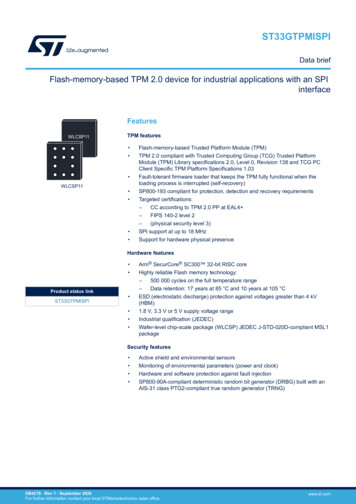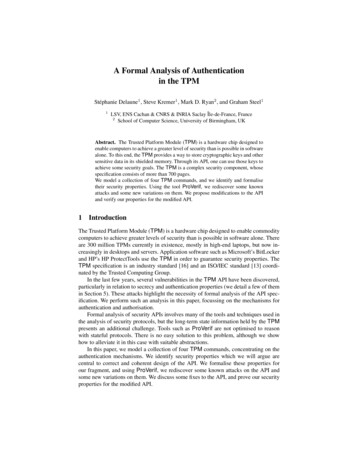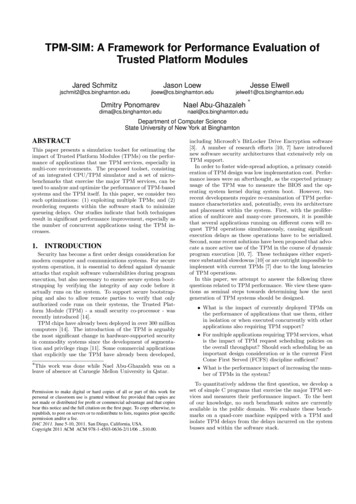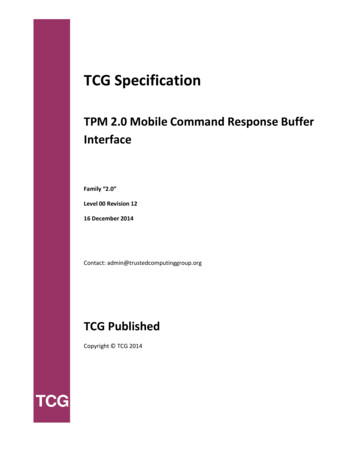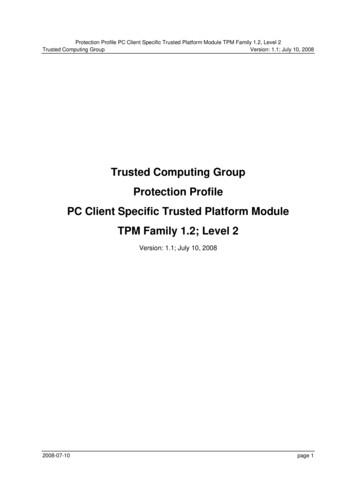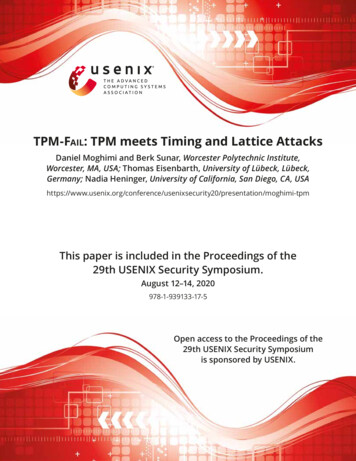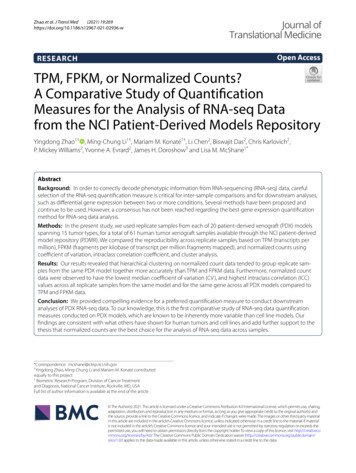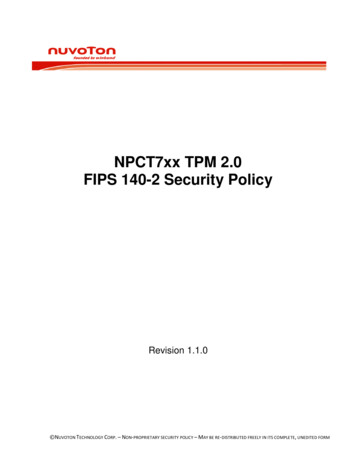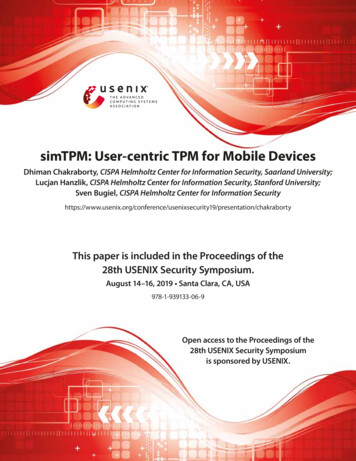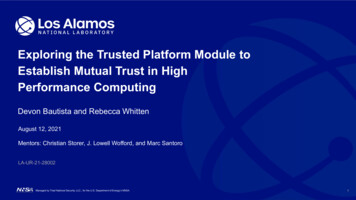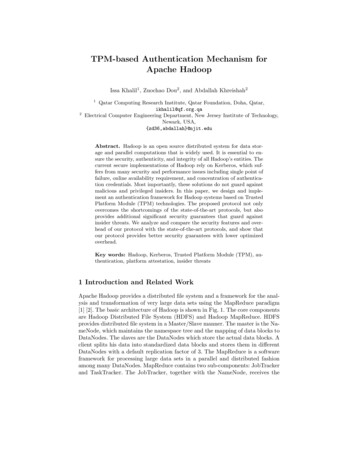
Transcription
TPM-based Authentication Mechanism forApache HadoopIssa Khalil1 , Zuochao Dou2 , and Abdallah Khreishah212Qatar Computing Research Institute, Qatar Foundation, Doha, Qatar,ikhalil@qf.org.qaElectrical Computer Engineering Department, New Jersey Institute of Technology,Newark, USA,{zd36,abdallah}@njit.eduAbstract. Hadoop is an open source distributed system for data storage and parallel computations that is widely used. It is essential to ensure the security, authenticity, and integrity of all Hadoop’s entities. Thecurrent secure implementations of Hadoop rely on Kerberos, which suffers from many security and performance issues including single point offailure, online availability requirement, and concentration of authentication credentials. Most importantly, these solutions do not guard againstmalicious and privileged insiders. In this paper, we design and implement an authentication framework for Hadoop systems based on TrustedPlatform Module (TPM) technologies. The proposed protocol not onlyovercomes the shortcomings of the state-of-the-art protocols, but alsoprovides additional significant security guarantees that guard againstinsider threats. We analyze and compare the security features and overhead of our protocol with the state-of-the-art protocols, and show thatour protocol provides better security guarantees with lower optimizedoverhead.Key words: Hadoop, Kerberos, Trusted Platform Module (TPM), authentication, platform attestation, insider threats1 Introduction and Related WorkApache Hadoop provides a distributed file system and a framework for the analysis and transformation of very large data sets using the MapReduce paradigm[1] [2]. The basic architecture of Hadoop is shown in Fig. 1. The core componentsare Hadoop Distributed File System (HDFS) and Hadoop MapReduce. HDFSprovides distributed file system in a Master/Slave manner. The master is the NameNode, which maintains the namespace tree and the mapping of data blocks toDataNodes. The slaves are the DataNodes which store the actual data blocks. Aclient splits his data into standardized data blocks and stores them in differentDataNodes with a default replication factor of 3. The MapReduce is a softwareframework for processing large data sets in a parallel and distributed fashionamong many DataNodes. MapReduce contains two sub-components: JobTrackerand TaskTracker. The JobTracker, together with the NameNode, receives the
2Issa Khalil et al.MapReduce jobs submitted by the clients and splits them into smaller tasks tobe sent later to TaskTrackers for processing. Each DataNode has a correspondingTaskTracker, which handles the MapReduce tasks.There are 5 types of communication protocols in HDFS: DataNodeProtocol (between a DataNodeand the NameNode); InterDataNodeProtocol (among different DataNodes); ClientDataNodeProtocol (between client and DataNodes); ClientProtocol (between a client and theNameNode); NameNodeProtocol (between the NameNode and the SecFig. 1. Basic architecture of Hadoop.ondary NameNode). On the otherhand, there are 3 types of communication protocols in MapReduce: InterTrackerProtocol (between the JobTracker and a TaskTracker); JobSubmissionProtocol(between a client and the JobTracker); and TaskUmbilicalProtocol (between taskchild process and the Tasktracker). In addtion, there is a DataTransferProtocolfor data flow of Hadoop.Hadoop clients access services via Hadoop’s remote procedure call (RPC)library. All RPC connections between Hadoop entities that require authentication use the Simple Authentication and Security Layer (SASL) protocol. On thetop of SASL, Hadoop supports different types of sub-protocols for authentication, such as generic security service application program interface (GSSAPI,e.g., Kerberos [3] [4]) or digest access authentication (i.e., DIGEST-MD5) [5].In practice, Hadoop uses Kerberos as the primary/initial authentication methodand uses security tokens (DIGEST-MD5 as protocol) to supplement the primary Kerberos authentication process within the various components of Hadoop(NameNode, DataNodes, JobTracker, TaskTracker, etc.). This Kerberos basedauthentication mechanism is first implemented in 2009 by a team at Yahoo [5].However, there are many limitations and security issues in using Kerberos forHadoop authentication. The first weakness of Kerberos lies in its dependency onpasswords. The session key for data encryption during the initial communicationphase to key distribution center (KDC) is derived from the user’s password. Ithas been shown in many situations that passwords are relatively easy to break(e.g., password guessing, hardware key-loggers, shoulder surfing etc.) mainly dueto bad or lazy selections of passwords. For example, in 2013, almost 150 millionpeople have been affected by a breach into Adobe’s database [6]. The breach isdue to mistakes made by Adobe in handling clients’ passwords. All passwordsin the affected database were encrypted with the same key. Additionally, theencryption algorithm used did not handle identical plaintexts, which results insimilar passwords being encrypted into similar ciphers. Disclosure of KDC passwords allows attackers to capture users’ credentials, which turns all Hadoop’ssecurity to be useless (at least for the owners of the disclosed passwords). Thesecond issue of Kerberos lies in having a single point of failure. Kerberos re-
TPM-based Hadoop3quires continuous availability of the KDC. When the KDC is down, the systemwill suffer from the single point of failure problem. Although Hadoop securitydesign deploys delegation tokens to overcome this bottleneck of Kerberos, it introduces a more complex authentication mechanism. The introduced tokens addextra data flows to enable access to Hadoop services. Moreover, many tokentypes have been introduced including delegation tokens, block tokens, and jobtokens for different subsequent authentications, which complicate the configuration and management of these tokens [7]. The third issue in Kerberos lies in itsdependence on a third-party online database of keys. If anyone other than theproper user has access to the key distribution center (KDC), the entire Kerberosauthentication infrastructure is compromised and the attacker will be capable ofimpersonating any user [8]. This issue highlights the insider threat problems inKerberos. Kerberos cannot provide any protection against an administrator whohas the privilege to install hardware/software key loggers or any other malwareto steal users’ credentials and other sensitive data (passwords, tokens, sessionkeys, and data).In early 2013, Intel launched an open source effort called Project Rhino toimprove the security capabilities of Hadoop. They propose Task HADOOP-9392(Token-Based Authentication and Single Sign-On) which is planned to supporttokens for many authentication mechanisms such as Lightweight Directory Access Protocol (LDAP), Kerberos, X.509 Certificate authentication, SQL authentication, and Security Assertion Markup Language (SAML) [9]. They mainlyfocus on how to extend the current authentication framework to a standard interface for supporting different types of authentication protocols. Nevertheless,all these authentication protocols, including Kerberos, are software-based methods that are vulnerable to privileged user manipulations. A privileged insidermay be able indirectly collect users’ credentials through, for example, the installation of malware/spyware tools on the machines they have access to in away that is transparent to the victims. Furthermore, Rhino trades off flexibilitywith complexity. It enhances the flexibility of the authentication mechanisms atthe cost of increasing the complexity of the overall system. Project Rinho didnot provide overhead analysis or performance evaluation which makes it hard tocompare with other protocols and raises questions about its practicality.In this work, we propose an TPM-based authentication protocol for Hadoopthat overcomes the shortcomings of the current state-of-the-art authenticationprotocols. To date, more than 500 million PCs have been shipped with TPMs,an embedded crypto capability that supports user, application, and machineauthentication with a single solution [10]. TPM offers facilities for the securegeneration of cryptographic keys, and limitation of their use, in addition to arandom number generator. TPM supports three main services, namely: (1) Remote Attestation which creates a nearly un-forgeable hash-key summary of thehardware and software configuration. The program encrypting the data determines the extent of the summary of the software. This allows a third party toverify that the software has not been changed or tampered with. (2) Bindingwhich encrypts data using the TPM endorsement key, a unique RSA key burned
4Issa Khalil et al.into the chip during its production, or another trusted key descended from it.(3) Sealing which encrypts data in similar manner to binding, but in additionspecifies a state in which the TPM must be in order for the data to be decrypted(unsealed). Since each TPM chip has a unique secret RSA key burned in as it isproduced, it is capable of performing platform authentication [11].In addition to providing the regular authentication services supported byHadoop, our protocol ensures additional security services that cannot be achievedby the current state-of-the-art Hadoop authentication protocols. In additionto eliminating the aforementioned security weakness of Kerberos, our protocol guards against any tamper in the target machines (the machine in the cloudthat is supposed to store users’ encrypted data and process it) hardware or software. In public cloud environments, the user does not need to trust the systemadministrators on the cloud. Malicious cloud system administrators pose greatthreats to users’ data (even though it may be encrypted) and computations.Those administrators, even though, may not have direct access to the user’sdata, they may be able to install malicious software (malware, spyware, etc.)and hardware (key loggers, side channels, etc.) tools that can ex-filtrate usersdata and sensitive credentials.In [12], the author proposes a TPM-based Kerberos protocol. By integratingPrivate Certification Authority (PCA) functionality into the Kerberos authentication server (AS) and remote attestation is done by the (Ticket-GrantingServer) TGS, the proposed protocol is able to issue tickets bound to the clientplatform. However, the present mechanism does not provide any attestation forHadoop internal components. Nothing can prevent malicious Hadoop insidersfrom tampering with internal Hadoop components. In this paper, we use TPMfunctionalities to perform authentication directly inside Hadoop to completelyget rid of the trusted-third-party.In [13], the authors propose a Trusted MapReduce (TMR) framework to integrate MapReduce systems with the Trusted Computing Infrastructure (TCG).They present an attestation protocol between the JobTracker and the TaskTracker to ensure the integrity of each party in the MapReduce framework. However, they mainly focus on the integrity verification of the Hadoop MapReduceframework, and did not address the authentication issues of Hadoop’s HDFSand Clients. The work does not provide a general authentication framework forthe whole Hadoop system.In [14], the authors present a design of a trusted cloud computing platform(TCCP)based on TPM techniques, which guarantees confidential execution ofguest VMs, and allows users to attest to the IaaS provider to determine if theservice is secure before they launch their VMs. Nevertheless, they do not providemuch details about how this work will be implemented and no performanceevaluation is provided. Also, this work does not focus on a general authenticationframework specific for the Hadoop system.In this paper, we design and implement a TPM-based authentication protocolfor Hadoop that provides strong mutual authentication between any internallyinteracting Hadoop entities, in addition to mutually authenticate with exter-
TPM-based Hadoop5nal clients. Each entity in Hadoop is equipped with a TPM (or vTPM) thatlocks-in the root keys to be used for authenticating that entity to the outsideworld. In addition to locally hiding the authentication keys and the authentication operations, the TPM captures the current software and hardware configurations of the machine hosting it in an internal set of registers (PCRs). Usingthe authentication keys and the PCRs, the TPM-enabled communicating entities establish session keys that can be sealed (decrypted only inside the TPM)and bound to specific trusted PCRs value. The bind and seal operations protectagainst malicious insiders since insiders will not be able to change the state ofthe machine without affecting the PCR values. Additionally, our protocol provides remote platform attestation services to clients of third party, possibly nottrusted, Hadoop providers. Moreover, the seal of the session key protects againstthe ability to disclose the encrypted data in any platform other than the onethat matches the trusted configurations specified by the communicating entities.Finally, our protocol eliminates the trusted third party requirement (such asKerberos KDC) with all its associated issues including single point of failure,online availability, and concentration of trust and credentials. Fig. 2 shows thehigh level overview of our protocol.We summarize our contributionsin this work as follows: (1) Proposea TPM-based authentication protocolfor Hadoop that overcomes the shortcomings of Kerberos. Our protocolutilizes the binding and sealing functions of TPM to secure the authentication credentials (e.g., Session keys)in Hadoop communications. (2) Pro- Fig. 2. High level overview of the authenpose and implement a periodic plat- tication framework.form remote attestation mechanism toguard against insider malicious tampering with Hadoop entities. (3) Perform performance and security evaluation of our protocol and show the significant securitybenefits together with the acceptable overhead of our new authentication protocol over the current state-of-the-art protocols (Kerberos). (4) Implement ourprotocol within Hadoop to make it practically available for vetting by Hadoopcommunity.The rest of this paper is organized as follows. In Section 2, in addition toproviding a background on the state-of-the-art Hadoop security design and theTPMs, we lay out our attack model. In Section 3, we describe our proposed TPMbased authentication protocol in details. In Section 4, we present the systemdesign and implementation method. In Section 5, we conduct the performanceevaluation of our proposed authentication protocol.
6Issa Khalil et al.2 Background2.1 Hadoop Security DesignApache Hadoop uses Kerberos to support the primary authentication in Hadoopcommunications. It introduces three types of security tokens as SupplementaryMechanisms. The first token is the Delegation Token (DT). After the initialauthentication to the NameNode using Kerberos credentials, a user obtains adelegation token, which will be used to support subsequent authentications ofuser’s jobs. The second token is Block Access Token (BAT). The BAT is generated by the NameNode and is delivered to the client to access the requiredDataNodes. The third token is the Job Token (JT). When a job is submitted,the JobTracker creates a secret key that is only used by the tasks of the job torequest new tasks or report status [5].The complete authentication process in Hadoop using Kerberos isshown in Fig. 3. The client obtains adelegation token through initial Kerberos authentication (step 1). Whenthe client uses the delegation token toauthenticate, she first sends the ID of Fig. 3. Authentication Process of HadoopSecurity Design developed by Yahoo.the DT to the NameNode (step 2).The NameNode checks if the DT is valid. If the DT is valid, the client andNameNode try to mutually authenticate using their own Token Authenticators(which is contained in the delegation token) as the secret key and DIGEST-MD5as the protocol (step 3, 4, 5 and 6) [15]. This represents the main authentication process in secure Hadoop system, although there are other slightly differentauthentication procedures such as the Shuffle in the MapReduce process.2.2 Trusted Platform ModuleThe Trusted Platform Module (TPM) is a secure crypto-processor, which isdesigned to secure hardware platforms by integrating cryptographic keys intodevices [11]. It is specifically designed to enhance platform security which isbeyond the capabilities of today’s software-based protections [16]. Fig. 4 showsthe components of a Trusted Platform Module.The TPM has a random number generator, a RSA key generator, an SHA-1hash generator and an encryption-decryption-signature-engine. In the persistentmemory, there is an Endorsement Key (EK). It is an encryption key that is permanently embedded in the Trusted Platform Module (TPM) security hardwareat the time of manufacture. The private portion of the EK is never releasedoutside of the TPM. The public portion of the EK helps to recognize a genuineTPM. The storage root key (SRK) is also embedded in persistent memory andis used to protect TPM keys created by applications. Specifically, SRK is usedto encrypt other keys stored outside the TPM to prevent these keys from beingusable in any platform other than the trusted one [17].
TPM-based Hadoop7In the versatile memory, the Platform Configuration Register (PCR) isa 160 bit storage location for integritymeasurements (24 PCRs in total).The integrity measurements includes:(1) BIOS, ROM, Memory Block Register [PCR index 0-4]; (2) OS loaders[PCR index 5-7]; (3) Operating System (OS) [PCR index 8-15]; (4) DeFig. 4. Components of a Trusted Platform bug [PCR index 16]; (5) Localities,Module [18].Trusted OS [PCR index 17-22]; and(6) Applications specific measurements [PCR index 23] [19].The TPM is able to create an unlimited number of Attestation Identity Keys(AIK). The AIK is an asymmetric key pair used for signing, and is never usedfor encryption and it is only used to sign information generated internally bythe TPM, e.g., PCR values [20]. For signing the external data, storage keysare required. A storage key is derived from the Storage Root Key (SRK) whichis embedded in the persistent memory of the TPM during manufacture. Usingthe generated storage key along with PCR values, one could perform sealingoperation to bind data into a certain platform state. The encrypted data couldonly be unsealed/decrypted under the same PCR values (i.e., the same platformstate).2.3 Attack ModelIn addition to the traditional external threats, we believe that clouds are moresusceptible to internal security threats especially from untrusted privileged userssuch as system administrators.Many enterprises are likely to deploy their data and computations amongdifferent cloud providers for many reasons including load balancing, high availability, fault tolerance, and security, in addition to avoiding single-point of failure and provider locking [21][22][23]. For example, an enterprise may chooseto deploy the NameNode in their home machine to provide high security byonly allowing local access to local managers, and deploy the DataNodes amongdifferent cloud platforms to distribute the storage and computational load. Obviously, this increases the probability of compromise of the DataNodes. If one ofthe DataNodes is injected with some malwares, Hadoop becomes vulnerable.In the public cloud deployments of Hadoop, a privileged user could maliciously operate on behalf of the user by installing or executing malicious softwareto steal sensitive data or authentication credentials. For example, a malicious system administrator in one of the DataNodes on the public cloud may be able tosteal users’ private data (e.g., insurance information etc.) that is stored in thecompromised DataNode. With the appropriate privileges, the administrator caninstall a malware/spyware that ex-filtrates the stored sensitive data. Kerberosbased Hadoop authentication cannot protect against such insider attackers andthus systems running Kerberos are vulnerable to this attack. In Kerberos-based
8Issa Khalil et al.secure Hadoop, the DataNode authenticates with other parties using delegationtokens, and the action of installing malware on the DataNode machine will notbe detected. On the other hand, the Trusted Platform Module (TPM) is capableof detecting the changes of hardware and software configurations, which will helpin mitigating such attacks.We assume attackers are capable of performing replay attacks. The attackercould record the message during the communication and try to use it to forge afuture communication message. Such replay attacks may cause serious problems,such as denial of service (keep sending the message to overload the server), orrepeated valid transaction threats (e.g., the attacker capture the message of afinal confirmation for a transaction, then he can repeatedly send it message to theserver and result in repeated valid transactions if there is no proper protection).3 TPM-based Hadoop Authentication ProtocolIn this section, we present the details of our proposed Hadoop authenticationprotocol. The key idea of the protocol lies in the utilization of TPM bindingkeys to securely exchange and manage the session keys between any two partiesof Hadoop (NameNode/JobTracker, DataNodes/TaskTracker and Client).To achieve this, we assume everyparty in Hadoop, namely, the DataNode, the NameNode, and the client,has a TPM. Fig. 5 depicts the highlevel processes of the protocol which Fig. 5. The high level processes of ourare explained in detail in the follow- TPM-based Hadoop authentication protoing sub sections. The protocol consists col (Client to NameNode in this example).of two processes, the certification process and the authentication process.3.1 The Certification ProcessThe certification process (which issimilar to that presented in [12]) istriggered by the client and is depicted in Fig. 6. The client’s TPMcreates a RSA key using the SRK asa parent. This key will be used asthe client’s Attestation Identity Keys Fig. 6. Certification process of the TPM(AIK[client]). The AIK [client] is then binding key.certified by a PCA. This process only takes place once during the initialization ofthe TPM (a one-time pre-configuration operation). The client’s TPM then creates a binding key that is bound to a certain platform (i.e., the private portionof the binding key is inside the TPM and could only be used in this platform),then we seal the private part of the binding key to a certain PCR configuration.Finally, the client uses the AIK[client] which is certified by the PCA to certify
TPM-based Hadoop9the public part of the binding key. The AIK[client] is not used directly for authentication in order to maintain higher security guarantees by minimizing thechances of successful cipher analysis attacks to disclose the key. The AIK[client]is only used to sign PCRs value and other TPM keys. We can certify the bindingkey directly through the PCA instead of using the certified AIK[client]. However,using the certified AIK[client] is simpler, faster and provides the same securityguarantees. Once we certify the AIK[client], we can use it to sign all kinds of keysgenerated by the clients’ TPM without referring back to the PCA, which greatlyreduces the communication overhead at the cost of local processing overhead.3.2 The Authentication ProcessIn the authentication process (Fig. 7), the client tries to authenticate itself to theNameNode and the NameNode authenticates itself to the client. The Client sendsa random number K1 along with the corresponding IDs (e.g., fully qualified domain name) to the NameNode. This message is encrypted by the public bindingkey of the NameNode. The NameNode sends a random number K2 along withcorresponding ID to the client. This message is encrypted by the public bindingkey of the client. Using K1 and K2 , both the client and the NameNode generatethe session key Key session K1 K2 . Note that only the correct NameNodecan obtain K1 by decrypting the message sent by the client using the NameNode’s SK bind, which is bind to the target NameNode’s TPM with a certainsoftware and hardware configuration (sealed binding key). Similarly, only thecorrect client can obtain K2 by decrypting the message sent by the NameNodeusing the client’s SK bind, which is bind to the client’s TPM with the appropriate software and hardware configurations. This ensures mutual authenticationbetween the client and the NameNode.The session key exchanged is then lockedinto a certain PCRs value in an operation known as seal operation using theTPM command Seal that takes the two inputs: the PCRs value and the session keyFig. 7. The authentication process (Seal(P CRsindexes, Key session)). This enof the TPM-based authentication sures that Key session can only be decryptedprotocol.using the hardware secured keys of the TPMin that particular platform state. By sealing the session key to specific acceptable hardware and software configurations (specific PCRs value), we protectagainst any tamper of the firmware, hardware, or software on the target machine through for example, malware installations or added hardware/softwarekey loggers. Moreover, the session key (Key session) is made to be valid onlyfor a predefined period of time, after which the session key expires and the authentication process has to be restarted to establish a new session key if needed.The validity period of the session key is an important security parameter in ourprotocol. Short validity periods provide better security in the case of sessionkey disclosure since fewer communications are exposed by disclosing the key.However, shorter periods incur extra overhead in establishing more session keys.
10Issa Khalil et al.Additionally, a nonce is added to every message (for example, N once K2 )to prevent replay attacks. Finally, message authentication codes (M AC) are included with each message to ensure data integrity. The communication messageformat is as follows: (M essage, M AC, N once K2 , IDs)key session.3.3 Periodic “Fingerprint” Checking (Cross PlatformAuthentication)In a non-virtualized environment, the Trusted Platform Module (TPM) specification assumes a one to one relationship between the operating system (OS)and the TPM. On the other hand, virtualized scenarios assume one to one relationship between a virtual platform (virtual machine) and a virtual TPM [24].However, Hadoop systems are master/slaves architectures. The NameNode isthe master that manages many DataNodes as slaves. If the number of DataNodes grows, the number of session establishment processes that the NameNodeis involved in also grows relatively. Each session involves many TPM operations(e.g., Seal and unseal). For large systems, the TPM may become a bottleneck dueto the limitation of one TPM/vTPM per each NameNode according to currentimplementations of TPM/vTPM.To address this issue and alleviate the potential performance penaltyof TPM interactions, we introducethe concept of periodic “Fingerprint”platform checking mechanism basedon the Heartbeat protocol in Hadoop(Fig. 8). The idea is to offload mostof the work from the TPM of theNameNode to the NameNode itself.However, this requires us to loosen our Fig. 8. Random attestation and Periodicsecurity guarantees and change the at- “Fingerprint” attestation illustration.tack model by assuming that the NameNode is “partially” trusted. Partially here,means that an untrusted (compromised) NameNode will only have transientdamage on the security of Hadoop system. A nameNode that gets compromisedwill only stay unnoticed for a short time since other interacting parties (suchas DataNodes) may randomly request attestation of the authenticity of the NameNode. In this on-demand attestation request, an interacting entity with theNameNode (e.g., DataNode, client, etc.) asks the name node to send a TPMsealed value of its current software and hardware configuration. If the requestingentity receives the right values for the PCRs of the NameNode within a predefined time, then the NameNode is trusted, otherwise a suspicious alert is raisedabout the healthiness of the NameNode. The response time to receive the sealedPCRs value from the NameNode is set to account for the communication time,the load on the NameNodes (size of Hadoop System), and the seal operationsassuming that the perpetrator controlling the untrusted NameNode will not beable to roll back the configurations of the NameNode to the trusted one withinthis time.
TPM-based Hadoop11As mentioned earlier, the PCR values inside the TPM captures the softwareand hardware configurations of the system hosting the TPM. Therefore, a particular PCR value can be considered as a “Fingerprint” of the correspondingplatform. We collect the “Fingerprint” of each entity that needs to interact withthe NameNode (e.g., DataNode) a priori and store it on the NameNode (Thiscan be achieved during the registration process of the entity to the NameNode).The Heartbeat protocol in Hadoop periodically sends alive information from oneentity to another (e.g., from DataNode to NameNode). Therefore, we configureeach entity interacting with the NameNode (e.g., DataNode) to periodically (orcan be configured to be on-demand) send the new PCR values (achieve by PCRextension operation) to the NameNode to check the consistency of the storedPCRs and the new PCRs. The TPM in the interacting entity signs its currentPCR values using its AIK key and sends the message to the NameNode. Whenthe NameNode receives the signed PCR values, it verifies the signature, and ifvalid, it compares the received values with the trusted pre-stored values. If amatch is found, the authentication will succeed and the session will continue.Otherwise, the authentication will fail and penalt
Apache Hadoop provides a distributed le system and a framework for the anal-ysis and transformation of very large data sets using the MapReduce paradigm [1] [2]. The basic architecture of Hadoop is shown in Fig. 1. The core components are Hadoop Distributed File System (HDFS) and Hadoop MapReduce. HDFS

